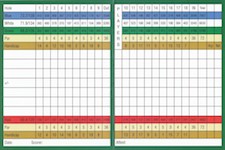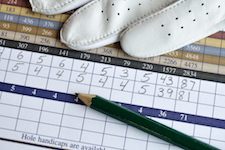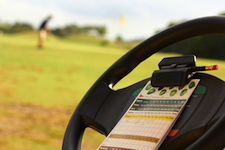HOLE 5:
SCORE CARD BASICS
To score or not to score? That is a very good question! For most beginners, getting the ball airborne and heading towards the hole is enough of a challenge - never mind counting the strokes to get there. At this stage, we recommend that you choose other ways to keep score. Many charity tournaments and business outings are set up as a team format, which takes the focus off playing your own ball. For social settings, we have developed the "Play Your Own Way" concept, which allows you to create your own rules so you can keep up with experienced players. As you begin to improve, you may decide to keep score in the traditional manner, but know that it is perfectly acceptable to play for years without keeping score. In this section, you will receive an overview of the scorecard and learn the basics of scoring in golf.
HOW TO READ A SCORECARD
Introduction
Most games keep score to determine a winner, and golf is no exception. In golf, players keep track of the number of strokes it takes to get the ball into the hole.
Each golf course provides a scorecard that is customized to the measurements of the course's unique design, but most scorecards are laid out in a similar fashion. Let’s take a look at the information on a typical scorecard and discuss how to track your score.
Hole Numbers
Across the top of a scorecard is a row numbered 1 to 18, representing the holes on the golf course. Typically, there will be a break between hole 9 and 10 with a column for totals, as players may choose to play only a 9 hole round.
Sets of Tees
Each golf course has various tee box choices which are usually identified by a color, such as black, blue, white and red. Across the scorecard will be a row for each tee box which corresponds to the colored tee markers on the course. Players will choose one tee box color and start from this location on each hole.
Universally, the red tees are typically the most forward and closest to the green. They are usually placed to avoid obstacles, making them a great choice for beginning golfers. The tee boxes furthest from the hole are the toughest tees the course has to offer. Not only are they the longest distance to the hole, but they are often placed to add an extra degree of difficulty.
For each tee color by hole, there are numbers that indicate the distance (in yards) from the tee box to the center of the green. On the tee box there is usually a plaque on the ground with the exact spot this measurement was taken from. Depending on where the tee markers and hole location is placed on that day, the actual distance may vary from the scorecard. And to add even more variation, the course will change the tee markers and hole location on a regular basis, thus changing the distances and challenge.



Par Information
In the left column, there is a box marked PAR with numbers ranging from 3 to 5 across the row. This tells you, hole by hole, how many shots a professional golfer is expected to put the ball in the hole. While this is an unrealistic target for most beginning golfers, it is a guide as to how long the hole will play.
Player Names
At the start of the game, each player's name is written in the blank spaces in the far left column. Players record the number of shots it takes to put the ball in the hole in the column under each hole number. As a beginning golfer you can use this column to keep track of other things rather then the traditional score. You might track how many times you hit the fairway on your drive, or the number of putts to get into the hole. You can also just rate the hole by how much fun you had with a happy, neutral or sad face!
Totals
There is a column after hole 9 and hole 18, where you will see the total number of yards by tee box and a score of par. Players will record their total score for the course and if you have the lowest number, you won the game! Often times, a player will refer to her score in terms of how many shots she had over or under par. For example, "My score was 22 strokes over par."
Additional Information
On the scorecard there will be a row labeled HDCP or HANDICAP with numbers 1 through 18 across the columns. This rating may differ by tee placement, so you may see a second set of numbers near the yardage for the most forward tees. This number rates the difficulty of each hole, with 1 being the hardest and 18 being the easiest. These numbers come into play during competitive formats as a way to even out the score.
For players recording scores to keep a handicap, the SLOPE and COURSE RATING will be entered as part of the calculation. These numbers are usually found on the back of the scorecard. Each golf course is judged for difficulty by a governing body for golf. The slope of a course is identified by a number ranging from 55 (least difficult) to 155 (most difficult). The course rating is a numerical value that includes decimal points. It’s basically the expected score for a golfer shooting par and is another way to quantify the course difficulty. These numbers may vary based on the set of tees played.






